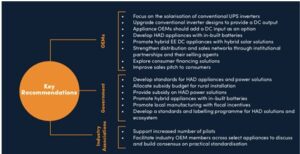While Indian Discoms continue to focus on AT&C loss reduction, which in many cases stands to the order of greater than 60%, and lot of private efforts is getting attracted in, it is clear that this is a massive Energy Efficiency (EE) drive. There are various talked instruments for EE financing, but not much has been realised by Indian Discoms. With this Rahul Bagdia from pManifold team spoke to Mr. Vinod Kala, Founder & MD, Emergent Ventures India. He has over 25 years of industry experience, centered on Clean Energy, Strategic Management and Finance. Over the years, he has helped launch a number of new businesses in Clean Technologies including Renewable Energy Aggregators in wind, hydro and bio-mass energy, LED Appliances, Sustainable Farming etc.
This interview focuses upon ‘If and how Indian Discoms could leverage & possibly expedite their AT&C loss reduction drive through potential financing from EE programmatic interventions’. The below shared are the author’s personal views and not to be associated with any of their company’s association.
- What are key Green House Gas mitigation related opportunities you see in Indian Discoms?
- AT&C loss reduction is of course one of the key areas of GHG mitigation for Discoms. EVI has successfully registered a Program of Activities (PoA) for Punjab State Electricity Board (PSEB). This was supported by World Bank. The PoA focused on transmission and distribution infrastructure up-garadtion in rural areas, which resulted in reduction of transmission losses.
- Other significant areas for Discoms, wherein Discom could play Aggregator or Program Manager role:
- ‘Reduction of leakages of SF6’: a high impact GHG substance used in circuit breakers because of its excellent insulating properties. UNFCCC AM35 is the approved methodology for designing carbon projects for reducing SF6 leakages.
- Demand- side management programs. Energy efficiency programs for residential customers (e.g replacement of light bulbs, fans etc). Energy efficiency programs for commercial and industrial customers (lighting, HVACs, process effy etc).
- Distributed renewable energy generation programs on customer premises (e.g solar roof tops, solar co-generation etc).
- Apart from Certified or Verified Emission Reductions (CERs or VERs), some of these initiatives could also qualify for other types of environmental credits such as RECs (Renewable Energy Certificates) / ECERTs (Energy Efficiency Certificates). The benefits could flow to users, investors or the Discom, depending on the structure of the Program.
- As far as Carbon Credits go, it is important to note that for projects registered after 2012, the saleability of carbon credits is low. The prices are also depressed. Hence the benefit of carbon credits can be meaningful only under bilateral mechanisms (e.g the mechanism with Japan).
- How did the PSEB CDM transaction work and what is current status?
- World bank had supported this initiative and Punjab State Electricity Board was the Managing Entity for the Program. The Program was registered in Dec 2012. The Program is still under implementation although it can go for verification for first year credits in 2013.
- AT&C loss reduction is one pointed goal for Indian power discoms. Any ideas on raising a programmatic intervention for raising useful finance? Will the new emerging private Distribution Franchisees benefit and look upon this as funding source?
- As I outlined earlier, new PoAs for CERs may not realise any significant monetary value because of sales restrictions on such credits from projects registered after 2012. However, an interesting possibility might to be extend the PSEB program to cover other Discoms as well. This will require further work by the interested Discoms with World Bank and learning from experience of PSEB.
- With RPOs enforcement getting stricter, what various market driven instruments are finding applications in Indian Discoms?
- RPO mechanism as it stands today is not very friendly to Programs integrating numerous, small sized project activities. Concept of Program of Activities under CDM is well designed for such integration. Also because of strict rules regarding who can buy (only Obligated Entities can) or sell (Only generators can) RECs, there are constraints on aggregation roles such as Program Managers. This needs further discussions with CERC.
- The current approach to meet RPO is therefore simple- either buy Renewable Energy under Preferential or Feed-in-Tariff or buy equivalent RECs. With slight modifications, if Program friendly provisions can be brought in, Discoms can meet their obligations partly through designing and implementing distributed Renewable Energy generation Programs.
- The other option for Discoms may be to devolve the RPO targets to large customers in Residential, Commercial and Industrial Segments. This will require working with SERCs and CERC for enabling provisions
- Indian Power discoms are seriously struggling with financial viability. Are ‘financial viability’ and ‘sustainability’ different dimensions, or are they interrelated?
- Sustainable development has become a national priority and therefore slew of policies are coming up, with inbuilt incentives or penalties to encourage sustainability initiatives.
- Therefore, sustainability should be looked with a fresh perspective. It is a business opportunity, with costs and risks if you lag behind and enhanced business value if you lead. It is no longer a feel- good activity undertaken only for reasons of conscience. Therefore sustainability and financial performance are not contradictory. Dis-coms can either be good at sustainability initiatives and benefit from related incentives or face the penalties.
- Discoms must also consider that Energy Sustainability is critical from the State perspective and would continue to be pursued. Both renewable energy and energy efficiency help reduce long term costs of energy, improve energy security and improve energy access, crucial for India’s development ambitions.
- Indian Discoms have three domains of sustainability work, which also positively influence financial performance:
- Technical efficiency and up-time improvement of transmission and distribution infrastructure, which reduces losses and improves throughput of energy in the system. Both positively impact the bottomline.
- Demand side management: efficiency improvement at customers end and flattening of peak load. Efficiency improvement by customers, specially in segments which are subsidized (such as agriculture or low income customers), will reduce the subsidies and release the energy capacity for high paying customers. Flattening of peak load will help the Discoms reduce average pooled cost of purchased power and thus improve the financials.
- Renewable energy generation – Long term cost of energy comes down. Present costs can also be brought down, if RPOs are implemented at customer level. Program management role can also unleash value for the Discom.
- What suggestions you will make to Discom and Franchisee Top Mgmt to pursue sustainability in true meaning?
- With sustainability thrust, new opportunities in Demand Side Management, Renewable Energy Generation etc. open up for Discoms or Distribution Franchisees. New revenue models, cost reduction opportunities and new ways of financing can be developed.
Posted by: Kunjan Bagdia @ pManifoldThese expert interviews are part of pManifold and IUKAN initiative to bring new ideas and help overall Indian Utility industry to grow strong and sustainable. Please bring to our attention if you would have interest to share your views with broader utility professionals and help drive this change. You can write us at contact@pManifold.com, and our team shall get in touch with you.



